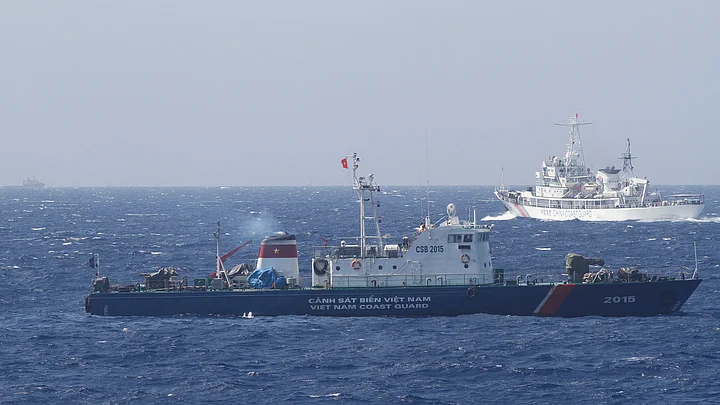The World Oceans Day celebrates the seas as a boon for mankind. It may soon turn out to be a bane for Sino-Indian relations. The problems are many and centre around the Exclusive Economic Zone (EEZ) defined by the United Nations Convention on the Law of the Seas (UNCLOS) as the sea area and seabed stretching 200nm from the coast and island territories, including the 12 nautical mile (nm) strip of water hugging the coasts of countries deemed sovereign territory, exclusively for the coastal country to mine and drill for offshore oil and gas.
South China Sea Contest
In a world where traditional energy and minerals sources are depleting fast, such resources are highly prized and as between states with extended coastlines and contested island territories, ever-elongated EEZs are reduced to a confusing welter of overlapping claims that are difficult to resolve because they are almost impossible to disentangle. EEZs do not, however, prohibit or limit in any way the right of free passage through these waters for merchant marine and even warships of all countries in peace time. But peace depends on how emphatically a country seeks to enforce its claims.
At the recent Shangrila Conference in Singapore, the head of the Chinese Navy Admiral Sun Jianguo talked plainly about the possibility of adding to the 2,000-odd acres of new “islands” brazenly created in mid-South China Sea by Beijing in violation of international laws and legal understandings. China dumped massive amounts of earth, sand, and silt, cemented these huge manmade outcroppings, and used them as air fields and impromptu naval bases, and has threatened to impose an air defence identification zone (ADIZ) in the area. Both the”islands” and the ADIZ are, however, capable of triggering war.
With the enhanced EEZ measured off these ersatz islands, China’s claims to all of South China Sea, Beijing believes, are incontestable. The extraordinary and entirely illegal cartographic actions notwithstanding, Admiral Sun averred that China had actually “exercised enormous restraint”! If this is restraint, many wonder what Chinese loss of self-control would entail. Such territorially expansionist policy involving the “near waters” is justified on the basis of millennial claims of this maritime region once being a Chinese “lake”.
The India Tangle
How is India affected by such shenanigans? For one thing, India has concessions and invested in oil fields in the very waters off Vietnam which China thinks it owns. Direct confrontation with China is likely also because Vietnam is being built up militarily by India in the manner Pakistan has been by China – to be a deep thorn in the side of the other. India needs only to transfer nuclear-tipped missiles to Hanoi to equilibrate the situation.
Besides, per geostrategic logic the more China is kept busy minding its marine backyard the less it may be inclined to open a front in the Himalayas and, even less, in the Indian Ocean. India and China as the rising powers in Asia, and the narrow straits – Malacca, Lombok, and Sunda – oceanically separating them, make for a picture of a giant dumb-bell with the two countries weighing down the two ends, with India at least for the foreseeable future having the naval edge west of Malacca, and China east of it.
Strategic Interests
As in most strategic matters, India woke up late to the military and economic significance of dominating the surrounding ocean, having been lulled by the view that the Indian peninsula jutting out into the sea like the prow of an aircraft carrier could easily muster overwhelming force by sea and air in the Sunda-to-Simonstown arc, which Chinese naval presence in the Indian Ocean cannot thwart.
India’s military advantage has been gradually eroded though by Beijing successfully cultivating littoral states and island nations with economic and military aid and infrastructure assistance (in pursuance of its “maritime silk route” strategy), until now when with Chinese-run Gwadar heaving into sight, China is positioned to give a good account of itself.
To augment its seaward economic heft India, on the basis of sedimentary and other scientific evidence and the extended continental shelf-principle, sought approval in 2010 from UNCLOS for nearly doubling its EEZ, stretching to 340nm into the sea from the mainland and its island territories (Lakshdweep, Minicoy, Andaman & Nicobar), thereby reserving substantial portions of the seabed for exploitation beyond the 2,708,139 sq kms already in its fold (versus 3,119,309 sq kms for China).
In the event, China’s deep sea mining ventures and aggressive naval patrolling in the Indian Ocean are to India what Indian naval flotilla sailings and oil exploration efforts off Vietnam’s shore are to China – ready provocation and cause for conflict.
(The writer is a Research Professor at the Centre for Policy Research and a national security expert.)
